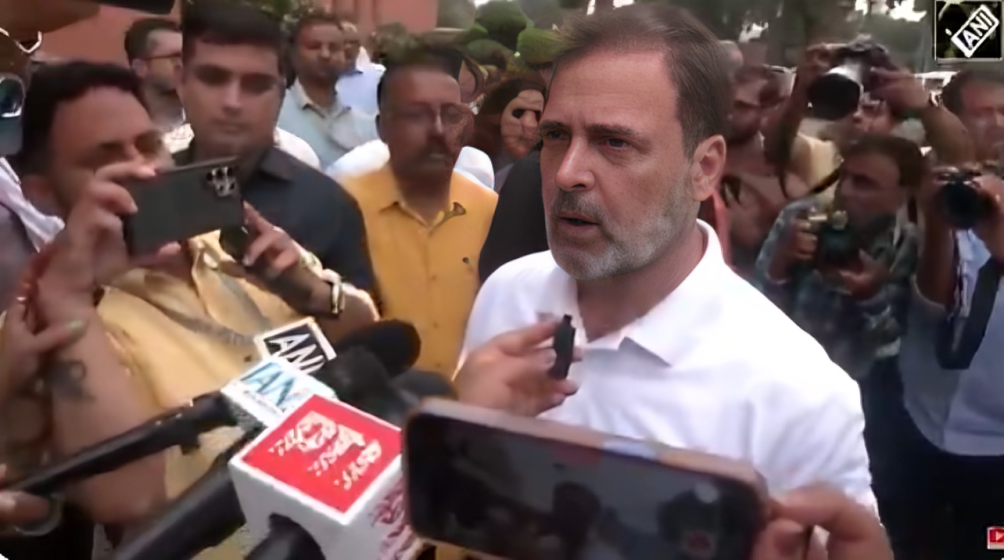India: A “Dead Economy” or a Political Misdiagnosis? The Real Story Behind Rahul Gandhi’s Bold Claim

In a country where politics and economics are often deeply intertwined, statements from national leaders can send shockwaves across sectors, headlines, and even borders. The most recent example of this came as a fiery political controversy erupted when Rahul Gandhi, Leader of the Opposition in the Lok Sabha, backed former U.S. President Donald Trump’s assertion that India is a “dead economy.” This strong remark, now trending widely across digital and political circles, has sparked a renewed debate: Is India’s economy truly in decline, or is this just another politically motivated narrative clash between Rahul Gandhi and Prime Minister Narendra Modi?
The Spark: What Triggered the “Dead Economy” Debate
The controversy began after Donald Trump, in a strongly worded statement amid renewed trade tensions, claimed that India and Russia are “dead economies” and imposed a 25% tariff on Indian exports to the United States. Trump cited unfair trade practices, high Indian tariffs on American goods, and geopolitical discomfort over India-Russia relations.
In a surprising move, Rahul Gandhi agreed with what Trump said and supported his comment in public, “Yes, he is right. Everybody knows this except the Prime Minister and the finance minister… The Indian economy is dead. Modi killed it.

With these words, Gandhi not only reignited the debate on the real state of the Indian economy but also drew attention to domestic issues such as unemployment, declining consumer demand, farmer distress, and alleged corporate favouritism.
Rahul Gandhi’s Critique: Key Economic Concerns Raised
Rahul Gandhi’s statement was not just a political jibe. It included a layered critique of the current government’s economic policies, pointing to what he believes are systemic failures under the Modi administration:
1. Crony Capitalism Allegations
Gandhi once again brought up the controversial Adani–Modi nexus, suggesting that the economic system is now skewed to benefit a select few large conglomerates while ordinary citizens and MSMEs struggle to survive.
2. Demonetisation and GST
The dual impact of demonetisation (2016) and a haphazard rollout of the Goods and Services Tax (GST) has, according to Gandhi, permanently damaged the informal sector. Small shop owners, street sellers, and people who earn money daily were badly affected, causing local businesses and income to slow down for a long time.
3. Make in India vs. Assemble in India
Criticising flagship initiatives like Make in India, he argued that these have failed to translate into meaningful domestic manufacturing or job creation. Instead, India has allegedly become a low-value assembly hub with minimal local value addition.
4. Consumption Decline and Inflation
Gandhi also said that people are spending less money these days. This can be seen in the drop in sales of important items like two-wheelers, daily-use products, and homes. Combined with rising inflation, he argued that household budgets are now stretched, especially in lower- and middle-income families.
5. Youth Unemployment
One of the most pressing concerns highlighted is India’s record-high unemployment, especially among youth. Despite claims of GDP growth, the lack of job opportunities and underemployment remains a critical issue.
The Modi Government’s Stand: Optimism Amidst Criticism
On the other hand, the Modi government says that India is still growing faster than any other big economy in the world. Government data points to:
Government officials argue that criticisms are politically motivated and overlook India’s recovery post-pandemic, manufacturing incentives (like PLI schemes), and rising foreign direct investments.
Global Angle: USA, Russia, and Trade Tensions
What makes this story even more complex is the international context. Trump's “dead economy” remark was not just directed at India in isolation—it came amid strategic friction between India-USA relations, especially over India’s ties with Russia. The U.S. has long expressed unease about India’s continued energy and defence cooperation with Moscow, even as New Delhi tries to maintain a delicate
balance.
Rahul Gandhi leveraged this moment to critique India’s diplomatic and trade policies, suggesting that India is losing credibility globally while simultaneously failing domestically.
Amplifying Opposition Momentum
The “dead economy” remark also fits into a broader opposition strategy that has recently gained traction. As seen in the Lok Sabha address by Gaurav Gogoi during the "Operation Sindoor" debate, there is a growing effort to connect issues of economic policy, national identity, and foreign policy into a single unified opposition front. You can explore this important speech and its significance in our latest blog: Operation Sindoor: The Battle for India’s Soul.
What Lies Ahead? The Road Forward
Whether India is truly facing a “dead economy” scenario or this is simply a politicised statement will be decided not just by economic indicators, but also by public sentiment and global positioning in the months to come.
As India heads toward the next phase of governance and global repositioning, one thing is clear: the economy has become the central battlefield in Indian politics. The Gandhi–Modi face-off, now catalysed by Trump’s unexpected intervention, will continue to dominate headlines.
In the short term, India will need to demonstrate not just resilience but inclusive growth, equitable wealth distribution, and employment generation to silence such accusations. The coming months will reveal whether these claims echo in voters’ minds or fade as another political flashpoint.
Conclusion
The “dead economy” remark is more than a soundbite—it reflects a deeper tension between political narratives, economic statistics, and public reality. Whether the Indian economy is slowing down or being strategically misrepresented is still a question up for debate. What remains undeniable, however, is that economic messaging will define India's political and global trajectory in 2025 and beyond.
Frequently Asked Questions
About the Author
Talk n Knock Team